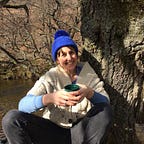On Jilly Sutton, Devon sculptor
Essay to introduce retrospective at Exeter Cathedral
put your ear to the river you hear trees
put your ear to the trees you hear the widening numerical workings of the river
right down the length of Devon,
under a milky square of light that keeps quite still
the river slows down and goes on
– River (extract) by Alice Oswald
Jilly Sutton has lived and worked on the banks of the River Dart for over 30 years. Tucked into the folds of a Devon hillside, the workshop where she carves is a barn piled high with chisels and chainsaws, moulds, trolleys, plaster casts and plinths, macquettes, jigsaw-prints and sculptures.
The barn looks out onto the serene and constantly shifting scenery of the estuary: a living sculpture of powerful tides, mists and mudflats, the roots and branches of ancient trees, seaweed, driftwood and the markings of wading birds at low tide. It is a landscape that predates and will outlive us.
Jilly’s artwork is steeped in this elemental landscape: the peaceful heads she makes hint at a slower, geological time, have the boldness and simplicity of myth. Godly figures, pagan divinities, winged angels are made solid, heroic in dimension, and placed in real time and physical space — in monochromes of white, vert-de-gris, and the most vivid blues. They have a mute ferocity, an otherworldly beauty: a reverence for myth, folklore and ecology.
The first head Jilly carved was a ‘Foliated Head’, or Green Man, which she made in 1989 out of eucalyptus. While she has also made abstract and non-figurative work throughout her career, heads have remained her preoccupation: she’s made hundreds in all. ‘If you like figurative work,’ she says, ‘the face is the most interesting part. I love it as a sculptural form.’
Her work is synonymous with wood: a substance often shunned by the fine-art establishment for lacking stone’s gravitas and durability, but of which Georg Baselitz said: ‘Objects made in it are unique, simple, unpretentious.’
‘Wood is not stable,’ Jilly says. ‘It splits, it warps, it rots; but it is the most loveable material.’
To carve it demands both craft and intuition, for the artist to push the timber to the limits of its plasticity and peel it into a form, yet respond to its existing contours, warps and wefts. wood is unpredictable, full of accident: every piece that is finished, stabilized and free of flaws represents a triumph of skill.
‘I love the sense of life you get from a tree,’ Jilly says. ‘Its warmth, tactility, its long history. I love trees growing, I love the wildlife they support even as they die, and I love working with them, knowing the relationship between each different tree’s contours and where you cut in: working in the knowledge that an oak’s grain will run all over the place; or that with lime it will run straight as a die.’
Whereas Barbara Hepworth and Henry Moore would import huge bulks of timber from Africa, Jilly only ever works with felled or fallen trees indigenous to the UK, supplied by a network of local foresters — and has never cut a tree down for sculpture. She avoids oak, ash and beech, preferring the grain in cedar, the line of lime.
She hollows out the backs of her sculptures, cutting away the dense, hard heartwood to take away the tension that causes splitting: a technique that has become a signature of her work. She sandblasts each piece to reveal the wood’s grain: like contours on a face, or ripples on the tide.
Her work runs from the very delicate to the gargantuan, from Grinling Gibbons to Baselitz. In her ‘Moth’ series, she shaved the backs of panels of wood so thin they disintegrated the image on the front — as moths dissolve and desiccate on a window-sill when they die. At the opposite extreme, she’ll work with huge sections of tree trunks — the remarkable ‘Fallen Deodar’ for example — a four-foot diameter sculpture carved from a single piece of wood with no splits, shakes, worm, rot, knots or beetles.
To go into her studio is to enter a place of calm alchemy, and to learn a new vocabulary of the natural world: a language of bronzes and resins, dyes and waxes, oxidations and pigments. As you sit among sketches and plaster casts — heads, seedpods, every imaginable body part, prints from birds’ wings, woodcuts, textiles and early workings of sculptures — she’ll tell you cassava’s resistance to dye, how to tap the sap from indigo’s leaves, the flying height of beetles, the glut of olive stones in the Levant, pull out tubs of pigments of such intensity they almost beggar belief: ground-up lapis lazuli, found in an old hardware shop in the back streets of Venice. ‘Like looking into Heaven,’ she’ll pronounce.
Jilly attributes her instinctive feeling for the human form to her first job as a nurse. She went on to study etching at Morley College, explored traditional indigo dyeing techniques when she lived in Nigeria in the late 1970s and began carving, running workshops and teaching part-time, when she and architect husband Peter Sutton moved to Devon. She graduated in Fine Art from Exeter College of Art in 1993.
Influences include Ana Maria Pacheco’s wood work, Igor Mitoraj’s sculptures, Baselitz’s carvings, the Benin bronzes, cathedral carvings, Nigerian ‘Ife’ terracotta heads, and the huge Gothic wood carvings in Prague, where an angel’s hand is the size of a car tyre.
